
After riding up the steep switchbacks to the mile-high lookout of Dante’s View, in Death Valley National Park, I straddled my motorcycle at the edge, looking west, and thumbed the kill switch. All was suddenly quiet and still, and I sat for a few minutes, facing that majestic vista, seeing it—and feeling it—as I had so many times before. For seven hours and almost 500 miles I had been wandering the backroads of California’s Mojave Desert, so I was a little sore and tired, and ready to “get there.” But I would not have missed that unparalleled viewpoint—hadn’t even considered passing by the winding little road up to Dante’s View.
Eighteen years and dozens of visits had not dulled its radiance. If anything, knowing the place so well made it more alive, with memories of viewpoints, hiking trails, mountaintops, and perhaps most vital of all, so many stories, personal and historic. Since my first sight of Death Valley, under a full moon in late 1996, to two days of filming scenes for my instructional DVD, Taking Center Stage, in various locations around the park in early 2011, my senses had been thrilled and my imagination inspired by one of my favorite landscapes.
Though it’s not really a landscape so much as a dreamscape. (I like the word the late great art critic Robert Hughes used to describe the paintings of Giorgio de Chirico: “oneiric”—dreamlike. And de Chirico, an early surrealist who founded the scuola metafisica, might be one artist who could have rendered Death Valley in paint.)
Death Valley is powerfully surreal and overwhelmingly strange, otherworldly. In some previous stories about spectacular views in the American West, I have resorted to musical metaphors—describing the sensory experience of standing before Grand Canyon as like a power chord, and the monumental rock formations of Zion Canyon as “frozen music,” specifically an orchestral G major. Seen from this elevation, Death Valley struck a mighty chord as well, but the harmonic convergence included a slight dissonance, a disturbing harmony, an eeriness.
From lower down, like sitting on the terrace of the Furnace Creek Inn at sea level, looking across the shimmering valley floor to the dark, chiseled Panamint Range, the music changes to a steady, thick drone of gradually shifting harmonies. I think of 2001: A Space Odyssey—that choral piece “Lux Aeterna” (eternal light, fittingly) by György Ligeti, like voices from Purgatory (likewise suitably “Dantean”).
The vast, sunken basin is the hottest, driest place in North America, and typically thrums with almost visible heat. Even on that early April day, it was 103 degrees at Furnace Creek. The stark bareness of it all—the white swirls of the “chemical desert,” the brown folds of bare rock in the Panamints behind—were the very definition of naked geology.
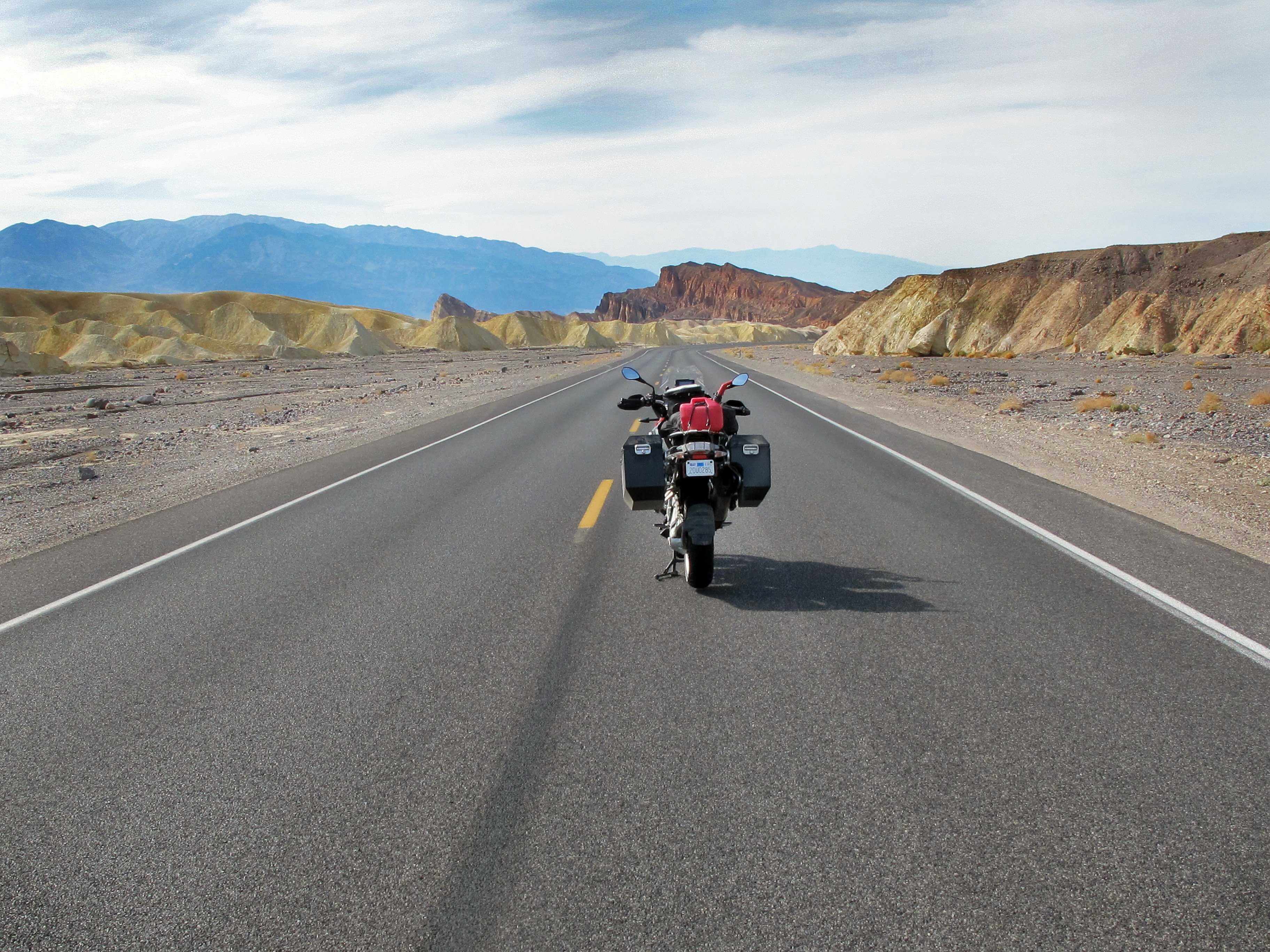
Looking out from Dante’s View, at 5,475 feet, is overwhelming to the senses, and the topography is endlessly fascinating—even just considering the numbers. From my mile-high vantage, I looked down at Badwater Basin, almost 300 feet below sea level, and across the valley floor to the chocolate-brown alluvial fans of eroded debris (called bajadas when they join), and the wrinkled brown shoulders of the Panamints. The view centered on Telescope Peak, the highest summit in Death Valley National Park, at 11,049 feet.
The snowy streaks visible in the opening photograph mark the area surrounding Telescope Peak, and seeing that made my heart sink a little. My plan for the following day was to hike up Telescope Peak and view that scene in reverse—from there to here. Now that might not be possible. (At such a moment, you wish you could hold a defiant fist up to a sky-god and shout, “Hey man—I trained for this!”)
I had last stood on that summit almost fifteen years before, in October, 1999. All unexpectedly, that place and time had marked a major turning point in my life—a hinge of fate, as it were. In writing my story of that time, in Ghost Rider, I came to realize that the hike up Telescope Peak was an important “plot point.” Dramatic. Symbolic.
Five-and-a-half years later, in April 2005, I planned a second attempt on Telescope Peak, but was warned by the park rangers that the higher elevations had too much snow and ice to climb without winter mountaineering gear—crampons and ice axes and such. I didn’t have any of those on my motorcycle. (Note to self: a man of your age and station ought to possess an ice axe.) So that day I hiked up nearby Wildrose Peak instead, at only 9,064 feet, and still had to work around or through a fair amount of snow.
This time, looking out from Dante’s View in April, 2014, I saw that snow, and knew that, like my motorcycle route that day, the next day’s hiking plans would have to be . . . improvised . . .
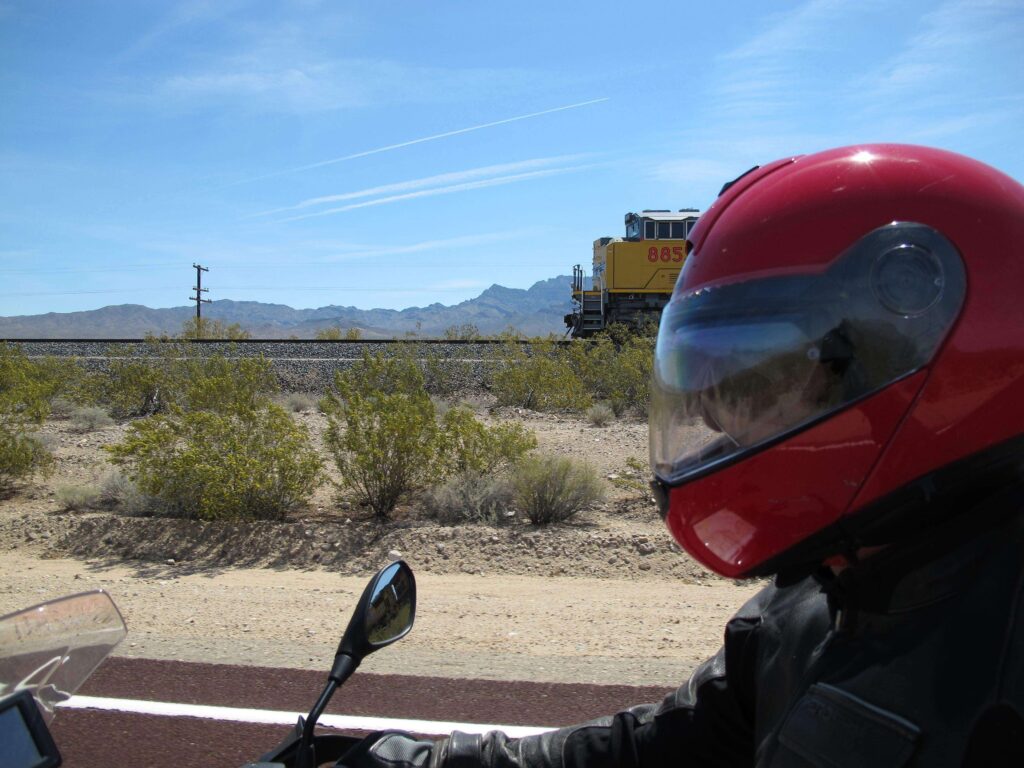
(As soon as I put away this camera)
Before setting out from home at dark o’clock that morning, I had not let myself decide anything about the route I would take, even the general direction. My only plan was to arrive at Stovepipe Wells in Death Valley by late afternoon—cocktail time—and there were many pleasant ways to accomplish that modest goal. After eighteen years of rambling around the Mojave, I knew its roads, major and minor, pretty thoroughly. Having lived in Southern California for over fourteen years, the desert was part of my “neighborhood,” like the majestic Sierras around Kings Canyon and Sequoia National Parks, or the Pacific Coast Highway up through Big Sur and the redwoods. So I could improvise a route at will—the most “liberated” of journeys.
In a choice between exploring a new route with map and GPS, or simply wandering among familiar favorite roads and turning at “whim-points,” the odds seem to favor the latter—much higher chances of having a great ride. Because experience.
Before publishing Roadshow in 2005, I had collected notes in 1996 and ’97 for a similar book I was going to call American Echoes: Landscape With Drums. Its writing was interrupted when some jealous deity or other worked in mysterious ways and took my family “to a better place”—but I found this passage from that draft, describing my first “enlightenment” about the Western deserts.
Until this time, I had never considered myself to be much of a “desert person.” As a nature-lover, I appreciate all kinds of landscapes, from seashore to farmland to prairie, but as already stated, my favorite is always forested mountains. Not necessarily big, majestic mountains like the Alps or the Rockies, but nice rolling land with trees and rivers or lakes, like the Black Forest, or my beloved Laurentians. It’s the dynamic topography, the foliage, the smells, the sheltered little roads, and the trees reflected in water.
However, the desert was starting to grow in my “soulscape.” The colors of tan and gray under wide blue skies, the hardy shrubs and cacti, but more than anything, it was a response to all that space. Brutus had spent a few years living near El Paso, and he told me that when he first went there he wasn’t too impressed by the landscape. It seemed bleak and empty; there was nothing there. Later he’d come to realize that this was the point—there was so much nothing there—and now this understanding was starting to creep into me.
For humans, perhaps the greatest luxury in the world is simply space, in all its forms. This is increasingly true on our ever-more-crowded planet (and the idea first occurred to me in China, and then again while sharing an eighteen-seat African bus with forty people), but it has been true since ancient times. Big buildings and big rooms have always been symbols of importance and prestige, and whether these extremes of “personal space” were built to house a king, a god, or a tycoon, their size is not necessarily a reflection of ego, but rather to provide and display the luxury of space. Even simple manifestations of this impression, like a magazine layout with generous blankness around its text and illustrations, play to the same sensibility in the viewer. Unlike other elements, the space is not there to do a job; it’s not “working,” it’s just plain, luxurious space.
When the horizon is low and flat on every side, like in the middle of an ocean or a desert, the sky cannot get any bigger. Mountains that seem clear and close are actually a hundred miles away, the full length of a train is stretched along the horizon in tiny blocks of color, and at night, the lights of an approaching town take forever to reach.
So the desert has space, it has nice air, it has good roads with stunning vistas of mountains and rugged cliffs, and it has little traffic. On this, our second crossing of the Mojave, I was feeling the desert in a way I never had before. Certainly the motorcycle had something to do with that.
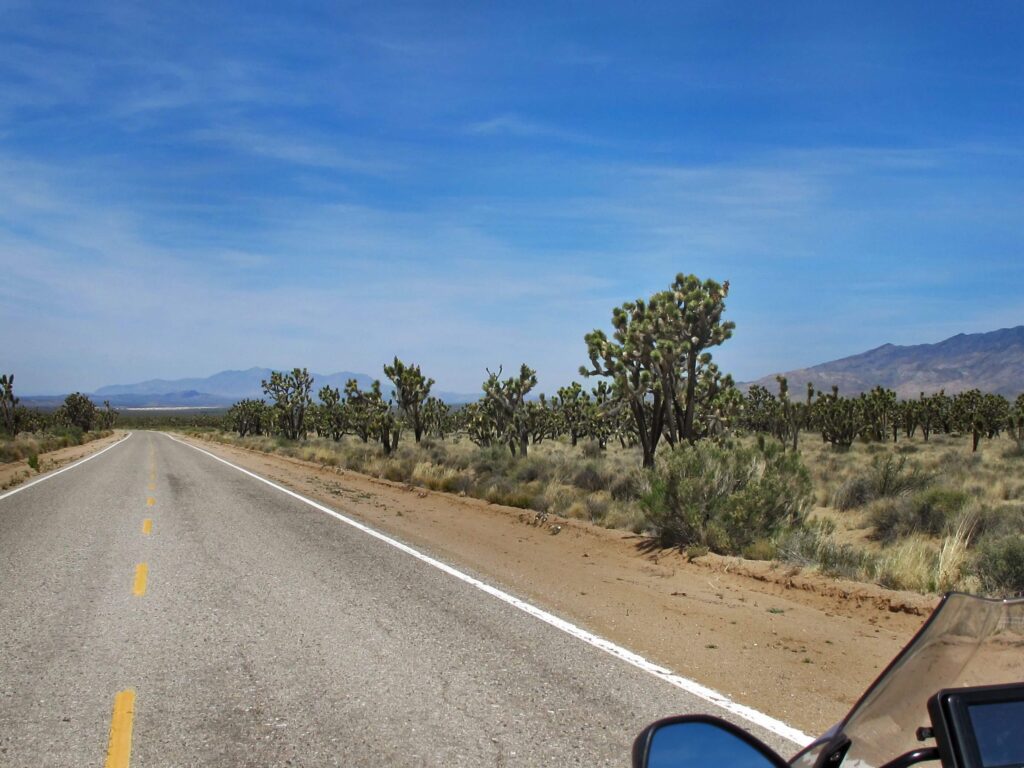
That morning, as I wheeled the bike out of the garage into the dark streets of Westside Los Angeles, it seemed suddenly clear that I should ride east on Interstate 10. Once through the megacity and past Palm Springs, into the open desert, I should turn off at Joshua Tree National Park. Heading north from there, I would have a choice of several two-lane routes through the Mojave, the high desert, in the general direction of Death Valley.
In early April, the weather was likely to be relatively cool, and I was looking forward to seeing the wildflowers in bloom. It wasn’t something you could ever count on—not a regular occurrence in that harsh environment, and even then short-lived—but it was something you could hope for. (A metaphor in there somewhere.)
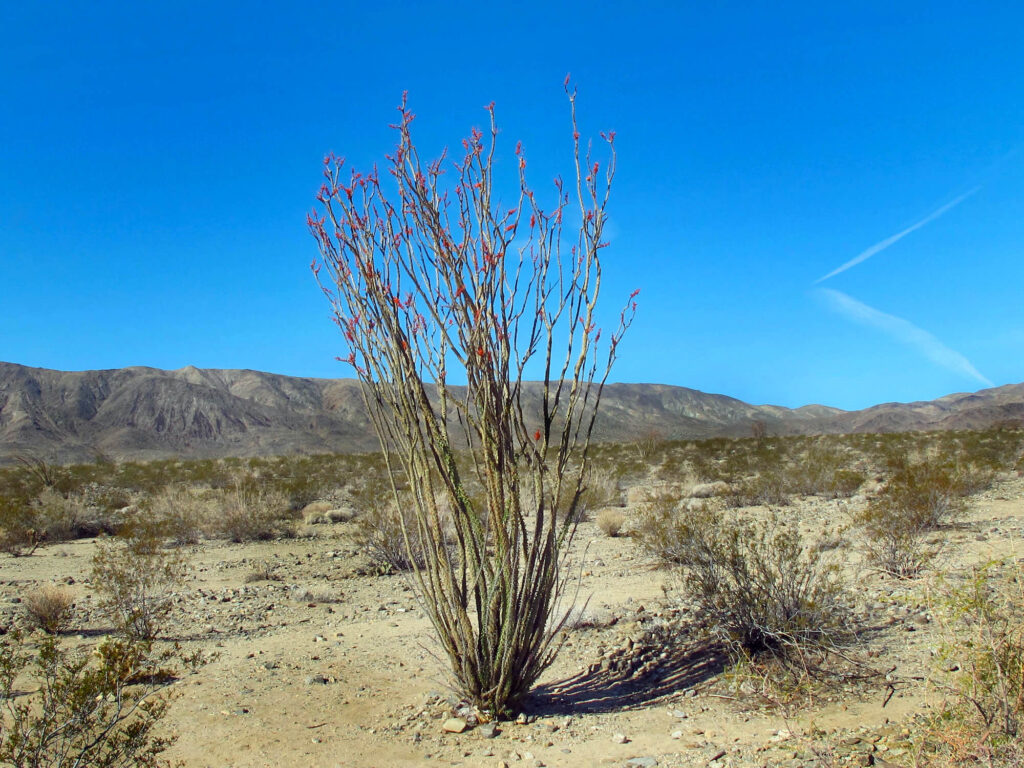
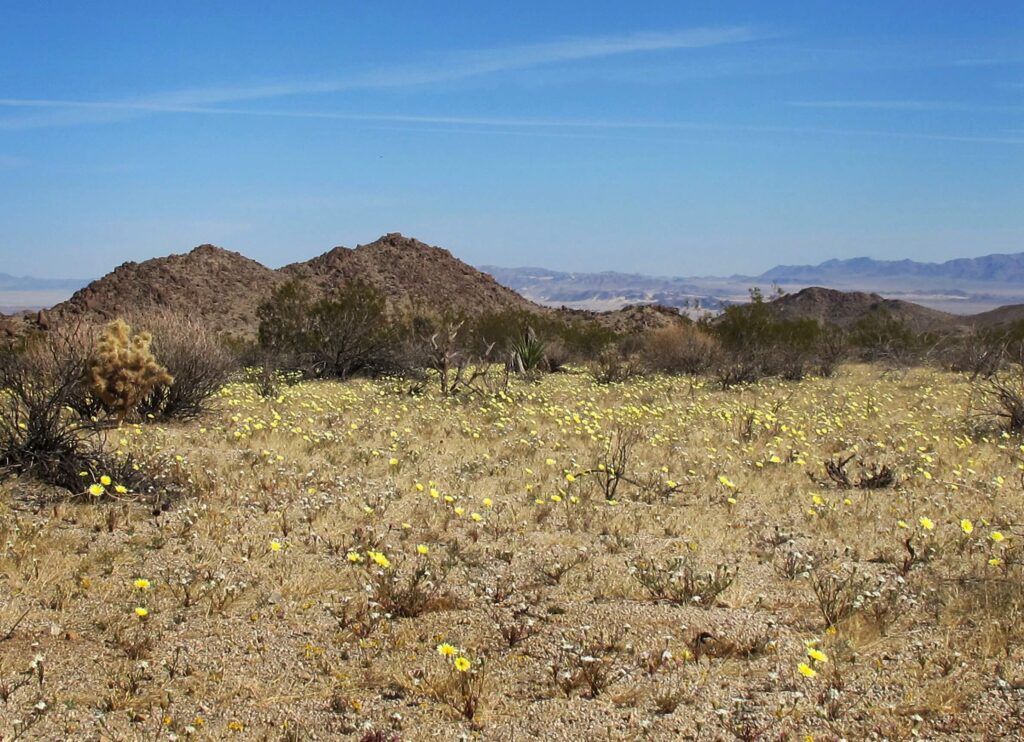
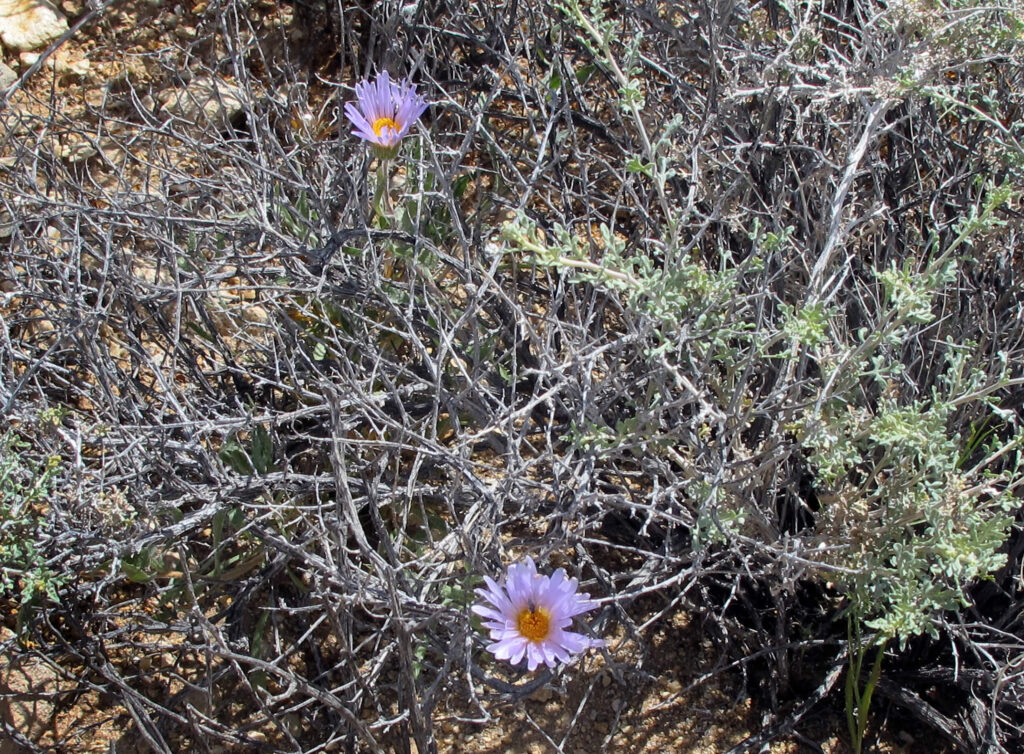
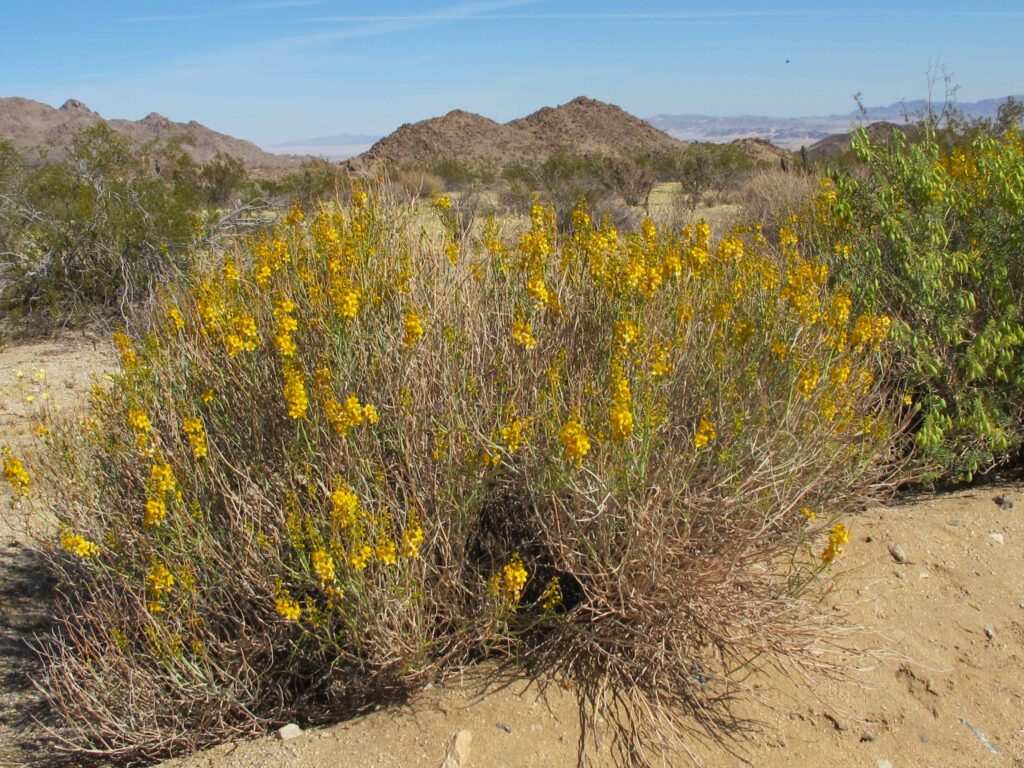
Years ago I had been surprised to learn that the busiest season for visitors in Death Valley is March and April. Because flowers. Perhaps the attraction can be compared to the autumn “leaf-peepers” who crowd the Northeast—New England, Ontario, Quebec—every October, in cars, minivans, SUVs, and bus tours. Both seasons offer a short, spectacular display, but the wildflower bloom in the Mojave is more subtle—and elusive. In fact, it only really shows off maybe once every twenty years, when the rain is timed and measured exactly right.
The rains had certainly been good for this sacred datura—the largest, liveliest plant of its kind I have ever seen in the Mojave. It glorified the roadside just outside Joshua Tree National Park, with Twentynine Palms in the background, and I saw several like it that day.
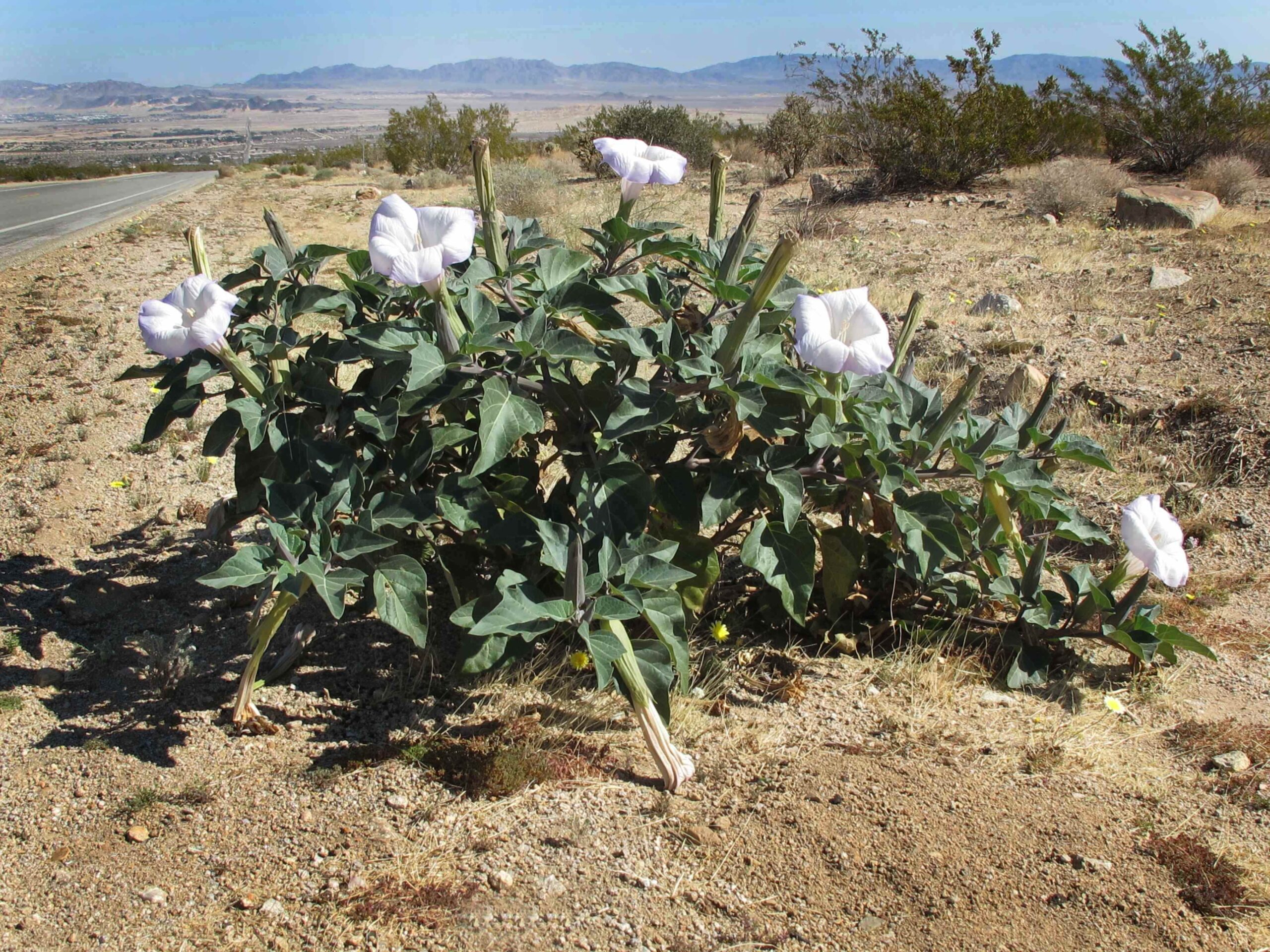
In other years, I had sometimes noticed a white, trumpet-shaped flower or two, laying pale and limp beside its dark stems and leaves in the roadside gravel. But this was a spirited-looking bloom indeed, the white petals standing proud, and delicately tinted around the outside with lavender. (Note the tiny yellow desert dandelions thriving in its shade.)
Many years ago a cab driver in Tucson told me sacred datura was a hallucinogen, and something about his manner said he spoke from experience. However, the entire plant is highly poisonous, and one description of a Zuni rite of manhood which included ingesting a drink made from sacred datura ends chillingly: “Not all of the boys survived.”
The plant is holy to some Native Americans (hence the name), and its observed effects gave rise to the disrespectful name “Indian whisky.” Also called jimsonweed, angel trumpet, moon lily, and in Spanish, yerba del Diablo—devil’s weed—it is used for the traditional “vision quest” ritual, when hallucinations are said to reveal the animal whose spirit dwells within you.
In the late ’60s and early ’70s, a popular series of “spiritual” books was written by Carlos Castañeda. (Now there’s a story—not just the books, but the author. After selling twenty-eight million books in seventeen languages, Castañeda retired from public life in 1973. He bought a mansion in Los Angeles, and started his own cult—“Fellow Travelers of Awareness”—with three female friends, who gave up their identities, families, and friends. Even his death, in 1998, was secret, and went unreported for two months. Later, the remains of one of the women was found near Death Valley.) Leading off with The Teachings of Don Juan: A Yaqui Way of Knowledge, in 1968, Castañeda’s books were notorious among the ’60s hippies for his experiments with psychedelics, especially peyote—but it was apparently datura tea he consumed on the vision quest when he reported turning into a crow and actually flying.
Coincidentally, in another vision quest, just the previous week friend Craiggie had fooled around with a photo from a hike I did in Topanga State Park with Greg Russell, and created this remarkable “hallucination.” I liked that it seemed to reveal my spirit as a ferruginous hawk—not some showy, vainglorious eagle, you understand, but just one step below, the largest of hawks. That would be cool.
However, I think I’ll take a pass on the datura tea, thanks anyway. Because poison.
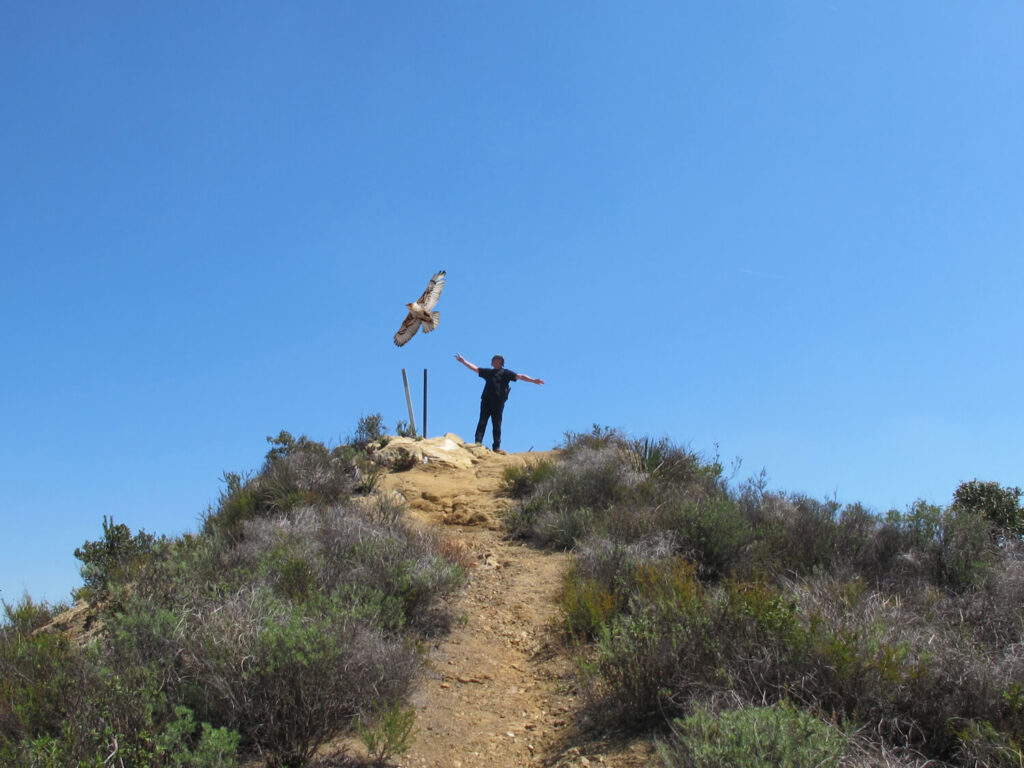
photo by Greg Russell
hallucination by Craig M. Renwick
In my years of desert travels on various vision quests, I have observed that in such a demanding, unforgiving environment, roads are demonstrably a good thing—not just for motorcycling and driving, but for the natural flora. Any rain that falls on the strips of pavement runs off to the side, bringing just enough extra moisture that the roadside shrubs are markedly larger than those in open country. In spring, the wildflowers thrive along the pavement’s edge.
Mile after mile, with rarely another vehicle in sight, I rode through the Mojave’s vast, oceanic sweep, distant brown peaks framing wide, gently undulating seas of patterned creosote. The creosote bushes grow in colonies, each a careful distance apart (either poisoning the soil around them with chemicals in their roots, or simply absorbing every drop of moisture—scientists are not sure), and collectively they are the oldest living organisms on Earth—some colonies over 10,000 years. A few of the creosote branches displayed their tiny yellow flowers, and I rode between tall, spindly ocotillos studded with blossoms like red jewels, and the fetching gesticulations of the Joshua trees. All the while, my eyes glanced down at the the evanescent wildflowers to either side—shy flecks of yellow, white, red, orange, and purple. Brittlebush, asters, desert paintbrush, datura, lupines, and a few others were familiar. Many others I couldn’t identify, but they delighted me just the same.
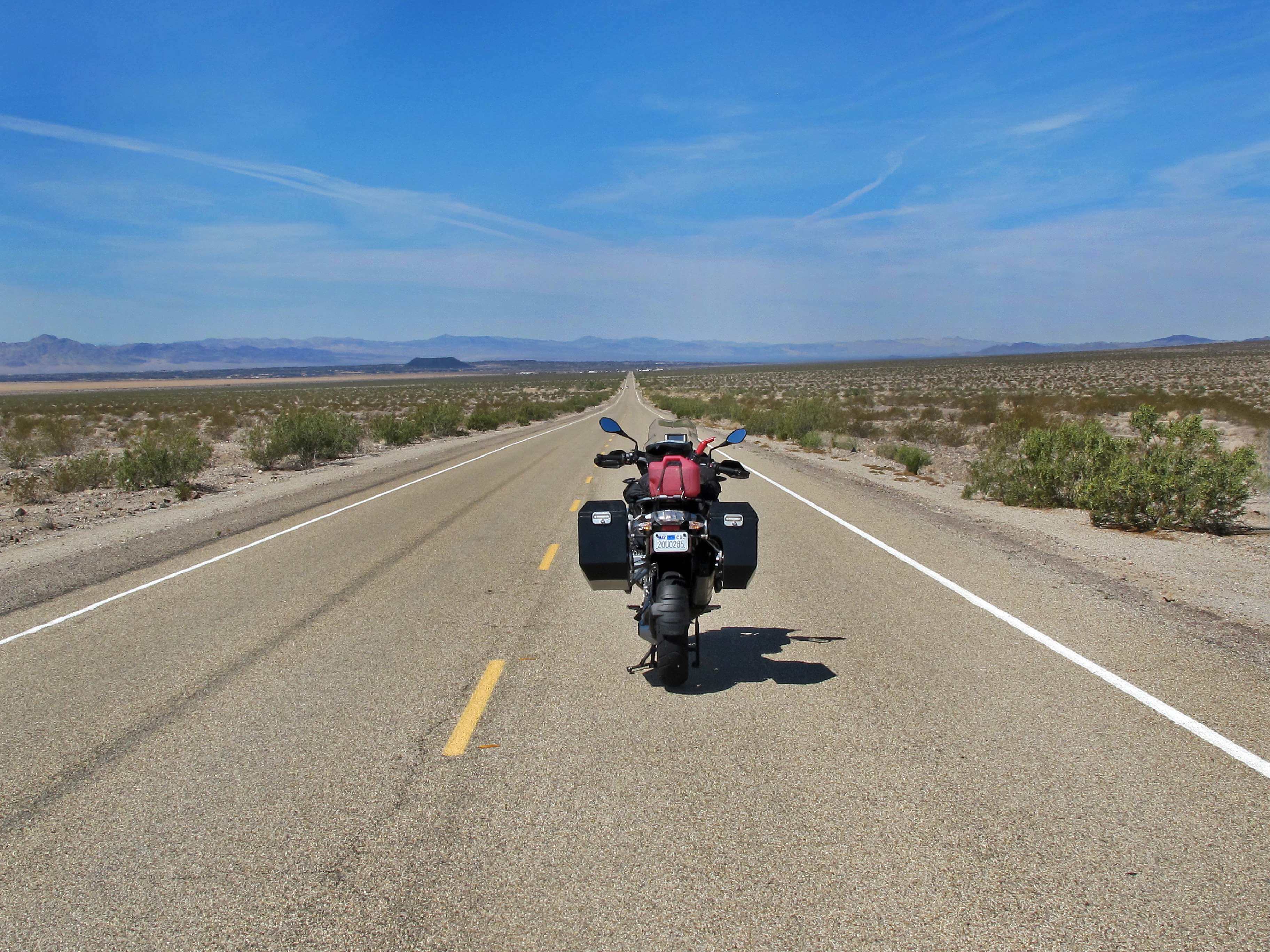
Riding out of Joshua Tree, I paused in Twentynine Palms for gas, then continued up the Amboy Road to Old 66. The above “Ghost Rider” shot—one of many in a sixteeen-year series—was taken there, looking west toward Amboy, Roy’s Motel in the distance, and the Amboy Crater to the left. Pretty well every time I pass that way, by motorcycle or car, I pause to set up a shot like this. I hope I always will.
Because memory.
Ahead of me, I still had some attractive route options to consider, and was reminded of another advantage to carrying my spare gas can, apart from emergencies: my choice of roads was less restricted by the location of gas stations. I turned north on Kelbaker Road, with a choice to make at Kelso Depot—at that fork I could stay left on the straight-through route up to Baker and Death Valley, or turn right onto the shunpikers’ choice, into the wilder parts of the Mojave National Preserve.
I shunpiked.
At the next fork, at Cima, I turned north to the intersection with Interstate 15, where I fueled up again. The temperature had climbed into the 80s, heading for the 90s, so I stripped off a few layers of gear, then crossed the freeway and rode back into open desert. A neglected, overgrown track of rough pavement called the Excelsior Mine Road curved west, traversing the remote, mostly abandoned mines of the Kingston Range. It climbed to a narrow, rocky little pass called after the next town, Tecopa, and I knew things could get difficult there. It was my third time passing that way, and the first time the unpaved pass had been rough; the next time it was even worse, and I was worried that by now it might have deteriorated to impassibility. One flash flood could do it. However, the Tecopa Pass had obviously been graded recently, which meant there was some kind of economic activity continuing around there—because it still followed my basic definition of a road’s purpose: “Money at one end, a bank at the other.”
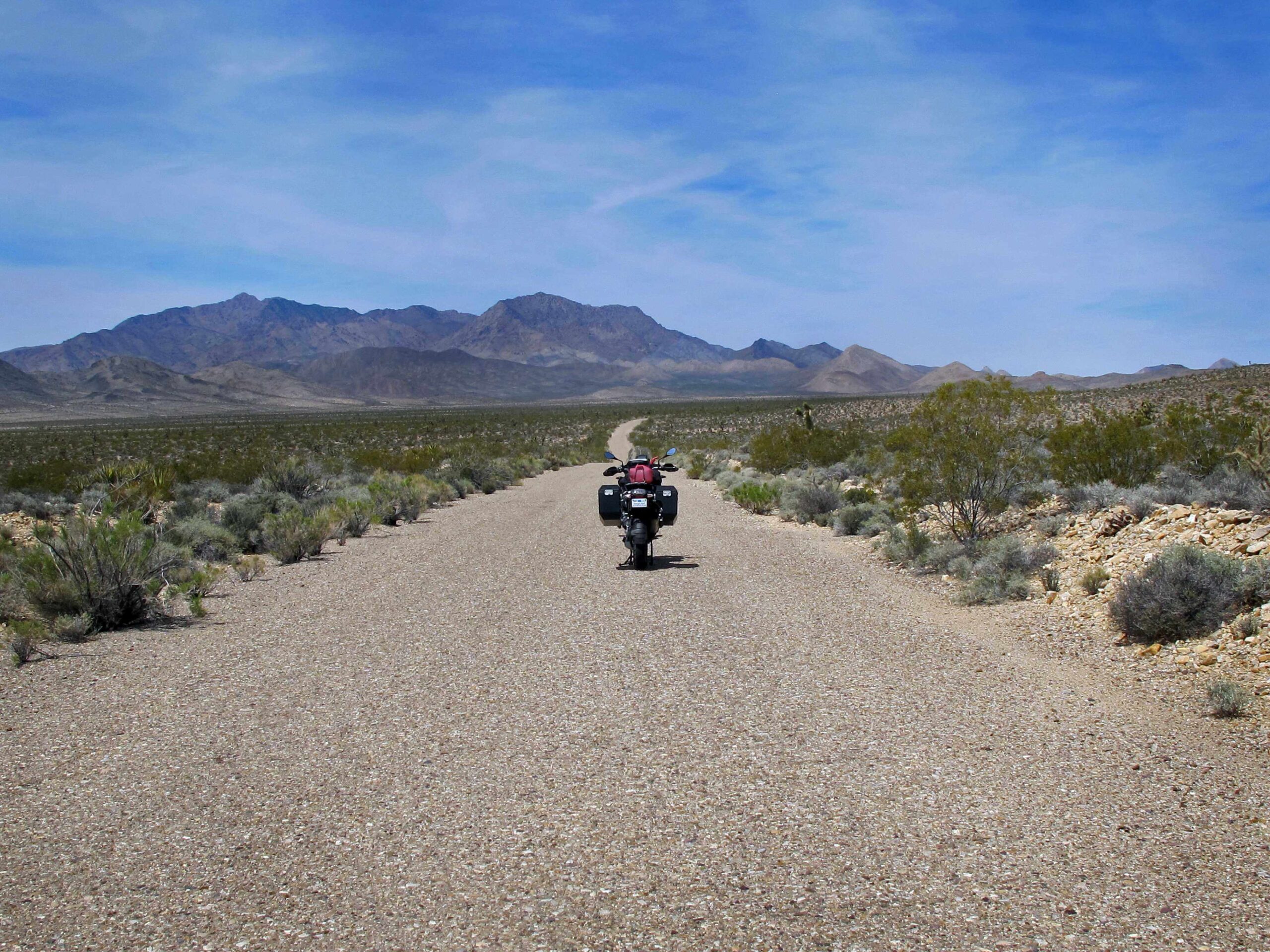
In the desert hamlet of Shoshone (population thirty-one in 2010, down from fifty-two in 2000), just outside Death Valley National Park, I decided to pause at the bar and grill called the Crowbar (heh-heh). Over the years I have often enjoyed their fine cheeseburgers and lemonade (I like how they serve it in Mason jars). As I stood outside by the bike, getting myself organized to head inside, I looked over at the gas station across the road. A gathering of numerous green dual-sport motorcycles clustered around the pumps, and I knew who they must be. Motojournalist friend Brian Catterson had told me he would be around Death Valley that week, attending a press introduction of the latest Kawasaki KLR-650 (long the benchmark for single-cylinder dual-sport bikes—meaning on- and off-pavement—since their introduction in 1987, so not exactly a “new model intro”).
Even from across the road I recognized Brian’s pyramid of thick hair above his gray Aerostich suit, and a moment later he looked over, saw me, and ambled across. When he got close, he grinned and said, “I recognize that gas can!” (He always likes to kid me for carrying that, as I always do between the Mississippi and the Coastal Ranges.) We shared a hug that was necessarily big and manly, both still encased in armored riding suits.
I knew the Kawasaki group was staying at the Furnace Creek Inn—part of the reason I had found that longtime favorite destination to be short of good rooms. In any case, I had already decided to stay at the budget-priced Stovepipe Wells property—still perfectly acceptable to this desert rat, and twenty-five miles closer to my hoped-for trailhead the following morning.
Stovepipe Wells is more-or-less in the middle of Death Valley, near the Mesquite Flat Sand Dunes (said to be the most photographed dunes in the world). A rambling compound of single-storey motel units (with park-in-front-of-your-door convenience), it offers a decent restaurant, a “saloon,” and a general store (mostly souvenirs) with gas pumps (Regular only). It did not boast the beauty or luxury of Furnace Creek Inn—or the spectacular “Lux Aeterna” view over the valley floor and across to the Panamints—but I had enjoyed those features numerous times before. This trip, Stovepipe Wells would be perfectly comfortable.
Brian suggested we get together later, but I said no, I’d just stay where I was—“With the poor people,” I laughed. I should have explained that the reason I didn’t want us to get together was that we were staying twenty-five miles apart, on motorcycles, so it wouldn’t be a good idea.
Because alcohol.
Of course I am a drinking man, but strict about it with regard to motorcycling. “No drinking and riding. Not even one.”
I made a mental note to explain that to Brian later, so he wouldn’t take it personally.
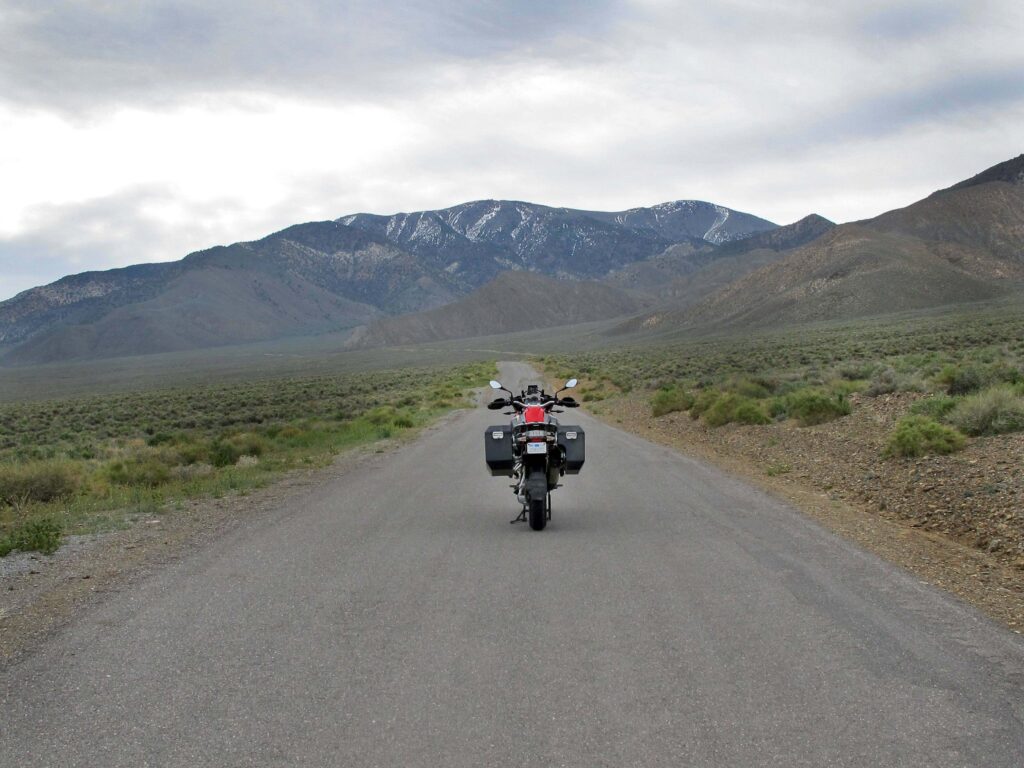
Early next morning I was riding up through Emigrant Canyon, into the higher-elevation meadows of sage and grasses. Wildflowers were especially plentiful there, in patches of yellow, white, blue, and dark red. I was aiming for the higher trailheads to Wildrose and Telescope Peaks. I figured I would just see how things were up there, then decide what would be possible. (Might be another metaphor in there.)
I am not one to believe in omens, but I do like symbols, and the idea of hiking up that trail to Telescope Peak again, almost fifteen years later, seemed heavily symbolic to me. The first time had come to represent a ragged line between a bad old life (ended badly, that’s all that counts for a long time) and a hopeful new life—between feeling completely disengaged from the world, then rejoining it.
Back in 2001, when I was in Toronto with the Guys at Work and trying to start on lyrics for a new album, naturally I had lots of “baggage” to work through. Some of that made it into songs; much did not. One of the lyrics I wrote for the Vapor Trails sessions was titled “Telescope Peak,” and though at the time it didn’t “sell” to the other guys, I still kind of like it. (Without bitterness, because “Ghost Rider” got put to music, and with coproducer Paul Northfield’s encouragement, recorded, so at least one of my “songs of the American road” saw the light of performance. Good enough!)
But here was me in 2001, thinking back to October, 1999, and wanting to write a song called “Telescope Peak.” The words still “sing” to me—an uptempo rocker in the verses, then hanging on the line “On the last lonely day” before dropping into a grinding groove for the bridges. The choruses, naturally, in gentler half-time. (When I’m writing lyrics, I always have an imaginary tempo and melody in mind, but never share that with the Guys at Work—just let them take it where it leads them. Good things happen that way.)
Looking back to the lowest low from the highest high
Way down to the burning white desert from the clear blue sky
On Telescope Peak, salvation just a day away
On Telescope Peak, I could have said goodbye to yesterday
— On the last lonely day
So many dreams are buried there
In ghost towns and abandoned mines
So many dreams are carried there
In the sound of the wind in the pines
— On the last lonely day
It’s the end of something
It’s the start of something too
It’s the end of something
It’s the start of something new
The last lonely day

